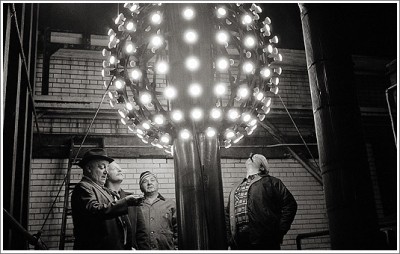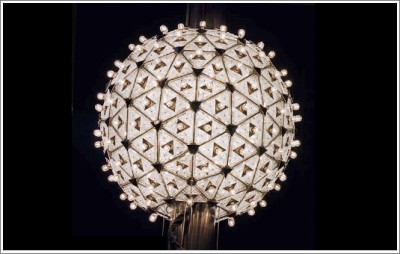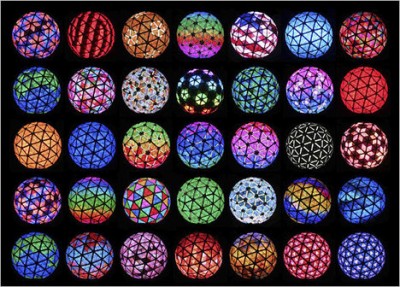What did you do to celebrate the New Year? If you haven’t ever been to Times Square on New Year’s Eve, odds are you’ve at least watched the ball drop on TV from a party or two. That moment when we collectively count backwards and sing “Auld Lang Syne” is one of those times when art fuses seamlessly into our existence, a cherished tradition.
Over the years, the ball itself – a fanciful amalgam of sculpture, craft and technology – has changed from time to time. The materials used in its construction relate directly to the era, so the ball is a beautiful physical manifestation of the passage of time and our status as a nation.
Here’s a little time line, courtesy of Wikipedia:
- 1907 – Walter F. Palmer, chief electrician for The New York Times, creates the first New Year’s Eve Ball with iron and wood materials with 100 25-watt bulbs weighing 700 pounds (320 kg) and measuring 5 feet (1.5 m) in diameter.
- 1920 – The Ball was replaced with an iron material Ball and weighing less than the original, only 400 pounds (180 kg).
- 1942 – 1943 – During World War II, the descending of the Ball was stopped due to wartime lighting restrictions in case of enemy attack.
- 1955-1980 – The Ball gets replaced with a lighter version made from aluminum weighing 150 pounds (68 kg).
- 1981-1988 – Due to the I Love New York campaign, there are red light bulbs and green stem in a design of an apple.
- 1989-1994 – The traditional white bulbs again get put on the Ball, except for 1991 and 1992, as a symbol to salute the troops in Operation Desert Shield, the ball is covered with red, white and blue light bulbs.
- 1995-1998– The Ball gets computerized, aluminum coated, rhinestone, and has a strobe light system.
- 1999 – The aluminum Ball gets replaced.
- 2000-2007 – The Ball gets an overhaul for the new millennium celebrations with a design from Waterford Crystal and new technology. It weighed 1,070 pounds (490 kg) measured 6 feet (1.8 m) in diameter and installed with 504 crystal triangles, illuminated externally with 168 halogen light bulbs and internally with 432 light bulbs of clear, red, blue, green and yellow colors.
- 2008 – For New Year’s Eve 2008, the ball gets a makeover in honor of its 100th Anniversary. Brand new state of the art LED lighting provided by Philips is featured instead of the less efficient halogen bulbs. The new LED fixtures produce over 16.7 million colors and can be programmed to create special effects.
- 2009 – The 2008 design is maintained, but its diameter is doubled, and it is 20% more energy efficient than the previous one.
- 2011 – Energy-efficient LEDs are again used to light the ball. 32,256 little Luxeon LED bulbs, to be exact. According to Philips who manufactures an ever expanding line of LED bulbs, they are commercially available and they consume 80 percent less energy when compared to traditional incandescent lightbulbs.
Sadly, photos of the actual balls are hard to find online. Perhaps they became scarce when MTV announced last year that it would be putting Snooki from the cast of Jersey Shore inside a ball. Notice they said “a ball”, not “the ball” – very tricky none the less!
Zatista wishes all of our WallSpin readers a very Happy New Year!
Related articles
- Gallery: a sneak peek of Times Square’s 2012 New Year’s Eve Ball (dvice.com)
- LEDs power Times Square ball on New Year’s Eve (news.cnet.com)
- Energy-Efficient Philips LEDs Light the Times Square New Year’s Eve Ball – PR Newswire (press release) (prnewswire.com)
- 2012: Year Of The LED Light Bulb? (earthtechling.com)






Comments (0)